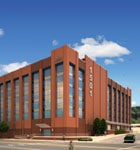After the collapse of the steel industry, the Pittsburgh region was left dotted with obsolete buildings. It’s in these buildings that Sampson Morris Group sees promise. The real estate developer, based in nearby Monroeville, Pennsylvania, grew out of a pre-World War II development company started by principal Ben Sampson’s father. Michael Morris joined Sampson in 1992. Five years later the two became partners and began buying properties they could renovate and give new life.
Because the steel industry crumbled, Sampson and Morris have their choice of vacant properties, and they chose not to limit themselves to one type of product. Instead, the limit is geographical. They concentrate on one particular region: western Pennsylvania.
The pair’s portfolio includes apartments, industrial buildings, entire lots, self-storage facilities, and research-and-development flex structures, among others. But Sampson Morris Group primarily purchases suburban Pittsburgh properties and creates value by applying adaptive-reuse strategies. And it’s an adept listener: changes in the economy or market needs often alter the company’s vision for a particular property. “Before we acquire something, we get a pro forma based on a specific plan,” Morris says. “That gives us the confidence to acquire it. Then we listen to what the market place tells us. Sometimes it changes our opinion.”
Sampson and Morris spend a great deal of time digesting what can be done with a property before doing anything. One of their latest projects, 1501 Penn Ave., was acquired under the assumption that they’d turn the former cold-storage facility into lofts. But, when the end-user financing for the lofts fell through, Sampson Morris Group held off on construction. “We thought 127 lofts would be a hard sell on the end-user side,” Morris says. “Since then we started looking at all the other options we have. In this particular case the marketplace told us not to [move forward].”
They began asking questions of their architects, Desmone & Associates Architects, searching for the best future use for 1501 Penn Ave. “We are constantly asking questions,” Morris says. “‘Can we remove columns? Can we put parking in there? Is it possible to build on top of the structure?’ We’ve probably done more extensive research on the 1501 Penn Ave. property than anything we’ve ever looked at.” What Sampson and Morris found was that the building is an incredibly flexible structure—they investigated the possibilities of 1501 Penn Ave. becoming a warehouse, a parking garage, a residence, or an office building. There were certain challenges no matter what they decided. According to Morris, the property on Penn Avenue has columns every 20 feet—like many industrial buildings—but buyers want column spacing every 40–50 feet. And it has two walls: a normal exterior wall and then a 12-inch gap between that exterior and the interior wall. “It’s a massive structure,” Morris says. “It is going to take extensive renovation to get the windows in, but we’ve done that before.”
In the end, what they had originally assumed would be a loft project will likely end as office space, based on current interest in the property. Morris is exploring the opportunity to do a living wall, living roof, and vertical solar panels.
Another challenging project was Robinson Self-Storage. The former Calgon Carbon Corporation property was a narrow building built on a hillside. It had small windows with numerous interior walls, making it structurally obsolete for an office or lab building. Sampson Morris Group concluded the best use of the building was a climate-controlled storage facility. “We were developing the entire 27-acre site with retail, a fitness center, offices, and this was the last piece,” Morris says. “It took us years to figure out what to do with the facility, but we finally let the market tell us. No other self-storage structures were in this area.”
Sampson Morris Group does its part to be sensible developers, taking unwanted, single-user buildings and turning them into flexible structures for multi-tenancy. Morris says that Pittsburgh’s demand for flexible office space created the need. “I would say we are slaves to demand,” he says. “Wherever the demand is, we want to offer the supply. This just happens to be a great way to do it.”


